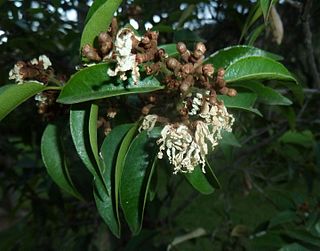
Olea capensis, also known by the common name black ironwood, is an African tree species belonging to the Olive family (Oleaceae). It is widespread in Sub-Saharan Africa from the east in Somalia, Ethiopia and Sudan, south to the tip of South Africa, and west to Cameroon, Sierra Leone and the Islands of the Gulf of Guinea, as well as Madagascar and the Comoros. It occurs in bush, littoral scrub and evergreen forest.

Fraxinus angustifolia, the narrow-leafed ash, is a species of Fraxinus native to central and southern Europe, northwest Africa, and southwest Asia.

Aloe excelsa is an arborescent aloe indigenous to southern Africa.
Keetia gueinzii is an evergreen scandent shrub in the Rubiaceae family. The species epitheton is named after Wilhelm Gueinzius, a German naturalist who collected plants in South Africa. It became the type species of Keetia after the original type species, Keetia transvaalensis, was made a synonym. This species is found down the southern African east coast in Malawi, Zimbabwe, Mozambique and South Africa.

Combretum erythrophyllum, commonly known as the river bushwillow, is a medium-sized to large, spreading tree found in bush along river banks in southern Africa. It is planted as a shade and ornamental tree in South Africa and the United States, and is propagated by seed.

Hakea pandanicarpa is a shrub species in the family Proteaceae. It is endemic to south-west Western Australia.
Acanthopale pubescens is a species of the genus Acanthopale of the Acanthaceae plant family. The species occurs in East and Southern Africa. Acanthopale pubescensis also known as Herayye in Ethiopia.

Euclea crispa, commonly known as the blue guarri, is an Afrotropical plant species of the family Ebenaceae. The hardy and evergreen plants may form a dense stand of shrubs, or grow to tree size. It is widespread and common in the interior regions of southern Africa, and occurs northward to the tropics. Though some are present near the South African south and east coasts, they generally occur at middle to high altitudes. It is readily recognizable from its much-branched structure and dull bluish foliage colour. Those bearing lanceolate leaves may however resemble the Wild olive, another common species of the interior plateaus.

Trichocladus crinitus is a species of the genus Trichocladus, in the family Hamamelidaceae. It is also called Black Witch-hazel.

Trichocladus grandiflorus is a species in the genus Trichocladus, in the family Hamamelidaceae. It is also called splendid witch-hazel.

Hymenodictyon parvifolium Oliv. is a small rubiaceous African tree and is one of some 24 species in the genus, with a tropical African and Asian distribution. This species grows as a small tree to some 5 metres tall, or sometimes a liane or scrambler to 10.5 m, and is found in low-altitude woodland.

Combretum hereroense, commonly known as the russet bushwillow and the mouse-eared combretum, is a deciduous shrub or small tree that is found from eastern Africa to northern South Africa. Over its extensive range it is variable with respect to leaf shape, fruit size and indumentum.

Fockea multiflora K.Schum. or Python vine/creeper is a large succulent liane, growing to some 15m in length and up to 60 cm in diameter, and found in Kenya, Tanzania, Zambia, Zimbabwe, Mozambique, Botswana, Namibia and Angola. Fockea comprises 6 species, all occurring south of the equator in Africa.

Chrysophyllum viridifolium, commonly known as fluted milkwood, is a potentially large species of evergreen milkwood tree that occurs in East African coastal forests, southerly coastal forest mosaics and in some inland forests of the tropics and subtropics.

Eucalyptus pruinosa, commonly known as silver box, silver leaf box, apple box or smoke tree, is a mallee tree that is native to Northern Territory the Kimberley region of Western Australia., and Queensland The Jaminjung peoples know the tree as yarrirra or jarnbiny, the Jaru know the tree as wararn and the Wagiman know it as wararn.

Boscia foetida, commonly known as the stink shepherd's tree, is an evergreen shrub or tree that is native to the warmer and drier parts southern Africa. It is found in semi-desert and arid bushveld, and in the west it occurs commonly in areas which are otherwise sparsely wooded. It is known for the particularly unpleasant smell of its flowers which appear during early spring, to which its specific name foetida alludes. Its freshly cut wood likewise has an unpleasant smell, and has traditional medicinal and magical uses, for instance as a protection against lightning.
Balanites pedicellaris, the small green-thorn or small torchwood is a small tree or shrub from Sub-Saharan Africa. It is a member of the caltrop family Zygophyllaceae.

Leucospermum saxosum is an upright evergreen shrub of up to 2 m (6.6 ft) high, that is assigned to the Proteaceae family. It has lance-shaped, leathery leaves and egg-shaped flower heads of about 5 cm (2.0 in) in diameter, with initially yellow-orange flowers, later turning crimson, from which long styles stick out, giving the flower head the appearance of a pincushion. It is called Escarpment pincushion in English. It grows on quartzite soils in the mountains on the Zimbabwe-Mozambique border and in eastern Transvaal.

Vexatorella obtusata is an evergreen shrub, with narrow, leathery leaves and about 2 cm big, globular flowerheads consisting of well scented, creamy pink flowers, from which a long style with a thickened tip extends. Two subspecies are distinguished, both restricted to different parts of the Western Cape province of South Africa. The creeping V. obtusata subsp. obtusata, also known as the Montagu vexator flowers from September to December, and the upright V. obtusata subsp. albomontana, also known as the Witteberg vexator, that has flowers between August and November.





















